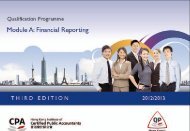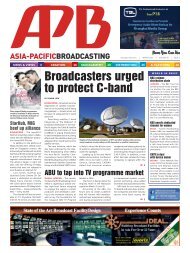NOTES TO THE FINANCIAL STATEMENTSFor the year ended 30 June 2009Note 1 Summary of significant accountingpolicies cont.(g) Deferred mining expenditureCertain mining costs, principally those that relate to thestripping of waste and operating development, which provideaccess so that future economically recoverable ore can bemined, are deferred in the balance sheet as deferred mining.Waste removal costs incurred in the development of a minebefore production commences are capitalised as part of themine development costs, which are subsequently depreciatedover the life of the operation.Removal of waste incurred once an operation commencesproduction is capitalised as mine development costs. Aproportion of the development and production waste costsare charged to the income statement as an operating cost.These costs are taken to production costs on the basis thateach ounce of ore produced bears the same average costof waste removal per ounce of ore, as determined by thewaste to ore ratio derived from the current mine plan. Thewaste to ore ratio and the remaining life of the mine areregularly assessed to ensure the carrying value and the rateof deferral is appropriate.(h) Taxes(i) Income taxThe income tax expense or revenue for the year is the taxpayable on the current period’s taxable income using theincome tax rate applicable at the reporting date, adjustedby changes in deferred tax assets and liabilities attributableto temporary differences between the tax bases of assetsand liabilities and their carrying amounts in the financialstatements, and by changes to unused tax losses.Deferred tax assets are recognised for deductible temporarydifferences and carry forward unused tax losses only if itis probable that future taxable amounts will be availableto utilise those temporary differences and losses.Current and deferred tax balances attributable to amountsrecognised directly in equity are also recognised directlyin equity.The Company and its wholly owned Australian entities havenot yet elected to implement the tax consolidation legislation.(ii) Goods and Services Tax (GST)Revenues, expenses and assets are recognised net of theamount of associated GST, unless the GST incurred is notrecoverable from the taxation authority. In this case it isrecognised as part of the cost of acquisition of the assetor as part of the expense.Receivables and payables are stated inclusive of the amountof GST receivable or payable. The net amount of GSTrecoverable from, or payable to, the taxation authorityis included with other receivables or payables in thebalance sheet.Cash flows are presented on a gross basis. The GSTcomponents of cash flows arising from investing or financingactivities which are recoverable from, or payable to, thetaxation authority are presented as an operating cash flow.(i) LeasesLeases of property, plant and equipment, where theconsolidated entity has substantially all the risks andrewards of ownership, are classified as finance leases.Finance leases are capitalised at inception of the lease atthe lower of the fair value of the leased property and thepresent value of the minimum future lease payments. Thecorresponding rental obligations, net of finance charges, areincluded in other long term payables. Each lease payment isallocated between the liability and finance charges so as toachieve a constant rate on the finance balance outstanding.The interest element of the finance cost is charged to theincome statement over the lease period so as to produce aconstant periodic rate of interest on the remaining balanceof the liability for each period. The property, plant andequipment acquired under finance leases are depreciatedover the shorter of the asset’s useful life and the lease term.Leases in which a significant portion of the risks and rewardsof ownership are retained by the lessor are classified asoperating leases. Payments made under operating leases(net of any incentives received from the lessor) are chargedto the income statement on a straightline basis over theperiod of the lease.(j) Business combinationsThe purchase method of accounting is used to account forall acquisitions of assets (including business combinations)regardless of whether equity instruments or other assetsare acquired. Cost is measured as the fair value of the assetsgiven, shares issued or liabilities incurred or assumed atthe date of exchange plus costs directly attributable tothe acquisition. Where equity instruments are issued in anacquisition, the value of the instruments is their publishedmarket price as at the date of exchange unless, in rarecircumstances, it can be demonstrated that the publishedprice at the date of exchange is an unreliable indicator offair value and that other evidence and valuation methodsprovide a more reliable measure of fair value. Transactioncosts arising on the issue of equity instruments arerecognised directly in equity.Identifiable assets acquired and liabilities and contingentliabilities assumed in a business combination are measuredinitially at their fair values at the acquisition date, irrespectiveof the extent of any minority interest. The excess of the costof acquisition over the fair value of the Group’s share ofthe identifiable net assets acquired is recorded as goodwill.If the cost of acquisition is less than the fair value of thenet assets of the subsidiary acquired, the difference isrecognised directly in the income statement, but only aftera reassessment of the identification and measurement ofthe net assets acquired.stbarbara.com.au – Annual Report 2009: 53
NOTES TO THEFINANCIAL STATEMENTSFor the year ended 30 June 2009Note 1 Summary of significant accountingpolicies cont.(j) Business combinations cont.Where settlement of any part of cash consideration isdeferred, the amounts payable in the future are discountedto their present value as at the date of exchange. The discountrate used is the entity’s incremental borrowing rate, beingthe rate at which a similar borrowing could be obtainedfrom an independent financier under comparable termsand conditions.(k) Impairment of assetsThe carrying value of all assets are reviewed half yearly todetermine whether there is an indication of impairment.Where an indicator of impairment exists, a formal estimateof the recoverable amount is made. An impairment loss isrecognised for the amount by which the asset’s carryingamount exceeds its recoverable amount. The recoverableamount is the higher of an asset’s fair value less costs to selland value in use. In assessing value in use, the estimatedfuture cash flows are discounted to their present valueusing a pre-tax discount rate which reflects current marketassessments of the time value of money and the risks specificto the asset. For the purposes of assessing impairment,assets are grouped at the lowest levels for which there areseparately identifiable cash inflows, largely independentof the cash inflows from other assets or groups of assets(cash-generating units).An impairment loss is recognised if the carrying amountof an asset or its cash generating unit exceeds therecoverable amount. Impairment losses are recognisedin the income statement.(l) Cash and cash equivalentsFor cash flow statement presentation purposes, cash andcash equivalents include cash on hand, deposits held at callwith financial institutions, other short term, highly liquidinvestments with original maturities of three months orless that are readily convertible to known amounts of cashand which are subject to an insignificant risk of changesin value, and bank overdrafts. Bank overdrafts are shownwithin borrowings in current liabilities on the balance sheet.(m) Trade receivablesTrade receivables are recognised initially at fair value andsubsequently measured at amortised cost, less provisionfor doubtful debts. Trade receivables are usually due forsettlement no more than 30 days from the date of recognition.Collectibility of trade receivables is reviewed on an ongoingbasis. Debts which are known to be uncollectible are writtenoff. A provision for doubtful receivables is established whenthere is objective evidence that the Group will not be ableto collect all amounts due according to the original termsof receivables. The amount of the provision is the differencebetween the asset’s carrying amount and the present valueof estimated future cash flows, discounted at the effectiveinterest rate. The amount of the provision is recognised inthe income statement.Funds placed on deposit with financial institutions tosecure bank guarantees are classified in the balance sheetas other receivables.(n) InventoriesRaw materials and stores, ore stockpiles, work-in-progressand finished gold stocks are valued at the lower of costand net realisable value.Cost comprises direct materials, direct labour and anappropriate proportion of variable and fixed overheadexpenditure relating to mining activities, the latter beingallocated on the basis of normal operating capacity. Costsare assigned to individual items of inventory on the basisof weighted average costs. Net realisable value is theestimated selling price in the ordinary course of business,less the estimated costs of completion and the estimatedcosts necessary to make the sale.(o) Non-current assets held for saleNon-current assets are classified as held for sale and statedat the lower of their carrying amount and fair value, lesscosts to sell, if their carrying amount is to be recoveredprincipally through a sale transaction rather than throughcontinued use.An impairment loss is recognised for any initial or subsequentwrite down of the asset to fair value less costs to sell. A gainis recognised for any subsequent increases in fair value lesscosts to sell an asset, but not in excess of any cumulativeimpairment loss previously recognised. A gain or lossnot previously recognised by the date of the sale of thenon-current asset is recognised at the date of de-recognition.Non-current assets are not depreciated or amortised whilethey are classified as held for sale.Non-current assets classified as held for sale are presentedseparately from the other assets in the balance sheet.(p) Investments and other financial assetsThe Group classifies its investments and other financialassets in the following categories: financial assets atfair value through profit or loss, loans and receivables, heldto maturity investments, and available-for-sale financialassets. The classification depends on the purpose for whichthe investments were acquired. Management determinesthe classification of its investments at initial recognitionand reevaluates this designation at each reporting date.54
















